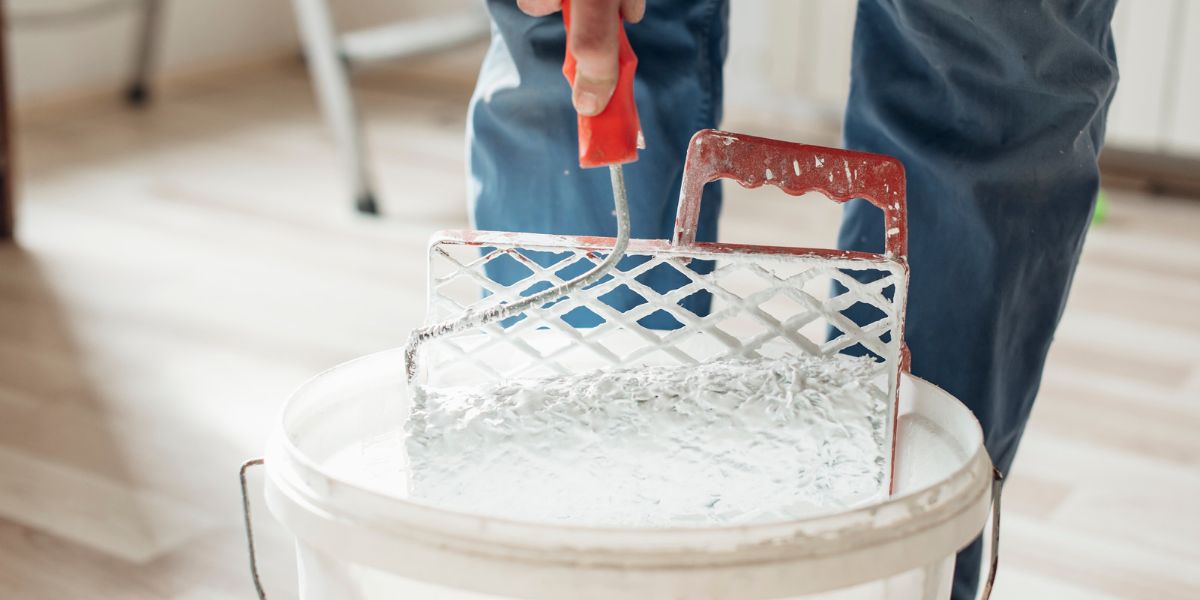
Have you ever experienced the frustration of having paint stains on your precious vinyl flooring? I know I have, and let me tell you, it is not a pretty sight. Not only does it look unsightly and ruin the aesthetics of your space, but it can also pose a safety hazard as it can make your floor slippery.
How to remove paint from vinyl flooring? The good news is that removing paint from vinyl flooring is not an impossible task. In this article, we’ll cover the process step-by-step to help you get rid of those pesky paint stains once and for all.
Explanation of the problem:
Vinyl flooring is a popular choice for its durability, affordability, and ease of maintenance. However, one common issue that homeowners face when dealing with vinyl floors is removing paint stains. These stains can occur due to accidental spills while painting walls or furniture or while using different types of paints, such as oil-based or enamel paints.
The problem with these stains is that they tend to be stubborn and difficult to remove without causing damage to the floor’s surface. If left untreated for too long, they can compromise the integrity of your flooring’s protective layer, causing discoloration or even peeling.
Importance of removing paint from vinyl flooring:
Removing paint from vinyl floors is essential not only for cosmetic purposes but also for maintaining their longevity and preventing any potential hazards. The longer you leave the stain untreated on your floor surface, the harder it becomes to remove it later on. Moreover, if left unaddressed for too long, these paint stains can seep through small crevices in your flooring material and eventually reach its subflooring causing structural damage.
RELATED: Bouncing Back: The Resilience of Resilient Flooring
How to Remove Paint From Vinyl Flooring
Now that we’ve established why removing paint from vinyl flooring is necessary, let’s take a brief look at how to do so successfully in just a few steps: – Gather the necessary materials such as paint thinner or remover, putty knife, warm water, dish soap, and a sponge. – Clear the area surrounding the stain and protect your hands by wearing gloves.
– Apply the chosen paint removal method (chemical, mechanical or natural) to your floor surface using a putty knife or a sponge. – Clean up any residue left behind with warm soapy water and let dry.
Removing paint from vinyl flooring is not impossible but requires patience and proper knowledge. With our step-by-step guide on how to do so successfully, you’ll be able to restore your flooring’s beauty and durability in no time.
Materials Needed
We all know that paint spills on vinyl flooring can be a nightmare to clean up. However, with the right tools for the job, you can make the process a lot less of a hassle. Here is a list of materials that you will need to remove paint from vinyl flooring:
Protective gear: First and foremost, your safety is important. Make sure you have gloves, goggles, and a face mask to protect yourself from chemical fumes or any debris created during the paint removal process.
Solvents: You will need something strong enough to break down the paint but gentle enough not to damage your vinyl flooring. Acetone, rubbing alcohol, and mineral spirits are all common solvents used in removing paint from vinyl floors.
Rags or towels: You’ll need plenty of rags or towels to clean up any debris or residue left behind after removing the paint. Squeegee: A squeegee is perfect for scraping off any excess paint on your floor before applying any cleaning solution.
Paper towels: Paper towels come in handy when dealing with small spills or drips on your floor. They’re also great for wiping down surfaces after cleaning.
Creative Alternatives
If you don’t have access to traditional supplies like acetone or mineral spirits, don’t worry! There are some creative alternatives that you can try: Vinegar: White vinegar is an excellent alternative to chemical solvents.
Mix equal parts of water and vinegar and use it as a cleaner solution. Vinegar will not only remove the paint but also leave your floor shiny and polished.
Baking soda paste: Baking soda paste mixed with water creates an abrasive cleaner that can break down stubborn stains like dried-up latex paint. Apply it directly onto the stain with a rag and let it sit for a few minutes before scrubbing it away.
Nail polish remover: Nail polish remover contains acetone, making it an effective alternative to traditional solvents. Apply it to the stain with a cotton ball and let it sit for several minutes before wiping it away with a damp cloth.
Removing paint from vinyl flooring requires some specific materials, but don’t worry if you don’t have traditional supplies because there are creative alternatives that you can use. Remember to always prioritize safety when handling chemicals and have plenty of rags or towels on hand to clean up any residue left behind.
Preparation: Clearing the Area and Protecting Surrounding Surfaces
Have you ever tried to remove paint from vinyl flooring without properly preparing the area beforehand? Let me tell you, it’s a complete disaster. Not only is it time-consuming, but it can also be dangerous if you accidentally spill chemicals or damage other surfaces in the process.
That’s why clearing the area and protecting surrounding surfaces are crucial steps to take before removing paint from vinyl flooring. First things first, clear out any furniture or objects that might get in your way during the process.
Trust me; you don’t want to be tripping over a chair while trying to scrub off paint with hazardous chemicals in hand. If possible, move everything out of the room altogether.
This way, you’ll have more space to work with, and there will be less chance of anything getting damaged. Now that everything is cleared out of the way let’s talk about how to protect surrounding surfaces.
You need to cover any nearby floors, walls or other surfaces that could get splattered with paint remover or any other harsh chemicals. A great way to do this is by using drop cloths or plastic sheets that can easily be taped down and removed when done properly.
Creative Ways To Prepare For Paint Removal
Now that we’ve talked about clearing out space and protecting surrounding surfaces, let’s explore some creative ways on how to prepare for paint removal on vinyl floors. One option is soaking a towel or rag in warm water before placing it over the affected area. This method works wonders because it softens up even dried-up paint stains making them easier to scrape off with a putty knife or scraper tool.
Another alternative is using baking soda mixed with water as a paste which can be applied directly onto the stain once it has been soaked in hot water for several minutes. The paste should then be left on for 15-20 minutes before being scrubbed away with a stiff-bristled brush.
This is a natural and effective way to remove paint without using harsh chemicals. If you’re dealing with stubborn paint stains that won’t budge, try using a heat gun or hairdryer on the highest setting to soften up the paint.
Once it’s soft enough, you can use a scraper tool to remove the paint from vinyl floors. Preparation is key when it comes to removing paint from vinyl flooring.
Make sure to clear out space and protect surrounding surfaces before starting any work. Also, don’t be afraid to get creative when preparing for the removal process; there are plenty of unconventional methods that can be just as effective as store-bought solutions!
Methods for Removing Paint from Vinyl Flooring
Chemical Methods: A Risky Business
When you’re dealing with paint spills on vinyl flooring, the temptation to reach for a chemical solution can be strong. However, it’s important to remember that chemicals can be harsh and even dangerous if not used correctly.
Chemical methods involve using solvents and strippers to break down the paint so it can be wiped away. Some common types of chemical solutions include methylene chloride, acetone, and mineral spirits.
These chemicals are highly effective at removing paint, but they also have their drawbacks. For one thing, they can produce noxious fumes that are harmful if inhaled.
Additionally, some solvents can cause discoloration or damage to the vinyl material itself. If you do decide to use chemical methods for removing paint from your vinyl flooring, make sure you follow all safety instructions carefully.
Wear gloves and goggles to protect your skin and eyes from contact with the chemicals. Also, remember to keep the room well-ventilated by opening windows or turning on a fan.
RELATED: Uncovering the Secrets: How to Remove Linoleum Flooring Like a Pro
Mechanical Methods: Good Old Elbow Grease
While chemical methods may seem like an easy solution for removing paint from vinyl flooring, sometimes a more old-fashioned approach is needed. Mechanical methods involve using physical force to scrape or sand away layers of dried paint until it comes off completely. One popular mechanical method is using a putty knife or scraper tool to gently pry up small sections of dried paint at a time – being careful not to damage the underlying surface beneath the vinyl flooring material itself.
Another method involves using sandpaper or abrasive pads attached to an oscillating power tool such as a sander or drill – which allows for a faster removal rate than scraping by hand alone would provide. Keep in mind that there are pros and cons when choosing mechanical methods over other forms of removal – for example, using a scraper tool may take longer than using chemical solutions, but it also doesn’t come with the same health and environmental risks.
Natural Methods: Chemical-Free Alternatives
If you’re looking for a safer and more eco-friendly way to remove paint from your vinyl flooring, natural methods may be just the solution you need. Some popular natural methods include using baking soda, vinegar, or citrus-based solvents like lemon juice.
One method involves making a paste of baking soda and water, then spreading it onto the affected area of your flooring. Let it sit for about 15 minutes before scrubbing gently with a cloth or soft-bristled brush.
Another option is to use vinegar – simply dampen a cloth with vinegar and then apply it directly onto the paint stain. Allow it to sit for several minutes before wiping up the excess liquid with another clean cloth.
While natural methods don’t have as much potential to harm you or your flooring as chemical ones do, they may take more time and effort on your part in order to achieve truly professional-looking results. Keep in mind that these options are best suited for smaller spills rather than larger areas that require extensive cleaning.
Aftercare
Removing paint from vinyl flooring is a labor-intensive process that requires careful attention to detail. However, the job doesn’t end once you’ve successfully removed all the paint from your floor.
Aftercare is just as important as the actual paint removal process. It’s essential to clean up any residue left behind and maintain your floor to ensure that it stays in its best shape for years to come.
Cleaning up after removing paint from vinyl flooring
Once you’ve removed all the paint, it’s crucial to clean up any remaining residue. Use a soft cloth or sponge soaked in warm water and mild soap to wipe down your floor thoroughly.
Make sure you don’t use any abrasive cleaners or scrubbers, as they can damage your flooring’s surface permanently. If there are any stubborn spots left on your floor, try using a cleaning solution specifically designed for vinyl floors.
Alternatively, mix baking soda with water and apply it on the affected area with a soft cloth before wiping it off with warm water. Once done, rinse the area with cold water and dry it immediately.
Creative ways to maintain a clean floor after painting removal
Maintaining your vinyl flooring is essential for its longevity. One of the best ways to do this is by keeping dirt and debris away from your floors using microfiber mops or soft-bristled brooms regularly.
To prevent future spills on your vinyl floors, consider placing rugs or mats in high-traffic areas such as hallways or doorways where spills are more likely to occur. Another creative way to keep your floors looking great after removing paint is by applying a protective coating such as wax or polish that will help prevent future scratches and scuffs while also giving them an attractive shine.
Removing paint from vinyl floors can be challenging but incredibly rewarding once finished correctly. However, don’t forget about aftercare!
Taking the necessary steps to clean up any remaining residue and maintaining your floors will help ensure that they stay in their best shape for years to come. With a little effort and creativity, you can keep your vinyl flooring looking new and stunning even after paint removal.
Frequently Asked Questions
Can you use paint remover on vinyl flooring?
Avoid using paint remover on vinyl flooring, as it can damage and discolor the surface.
Is paint thinner safe on vinyl flooring?
Paint thinner is not safe for vinyl flooring as it can potentially dissolve or harm the surface.
What is the best way to remove paint from flooring?
To remove paint from the flooring, scrape gently with a plastic scraper or use a citrus-based cleaner and a soft cloth. Test in an inconspicuous area first.
Will acetone remove paint from the vinyl floor?
Acetone may remove paint from vinyl floors but should be used cautiously and tested on a hidden spot beforehand.
What removes dried paint from vinyl?
Remove dried paint from vinyl by gently scraping with a plastic scraper or using warm soapy water. Test rubbing alcohol sparingly on a small area if necessary.
Can you clean vinyl floors with alcohol?
Diluted isopropyl alcohol can generally be used to clean vinyl floors, but check the manufacturer’s recommendations and perform a spot test before applying it to the entire floor.
Conclusion
Summary of the process: Removing paint from vinyl flooring may seem like a daunting task, but with the right materials and methods, it can be accomplished easily. The chemical method involves using solvents to dissolve the paint and wiping it away. Mechanical methods include using sandpaper, a scraper, or a heat gun to physically remove the paint.
Natural methods involve using hot water, vinegar, or baking soda mixture for an eco-friendly approach. Creative ideas on how to avoid future accidents: Prevention is always better than cure when it comes to avoiding paint spills on vinyl floors.
If you are planning on painting your home or any surfaces near your vinyl floorings, then ensure that you have covered them entirely with plastic sheets or newspapers. In case of small spills, try cleaning them up immediately before they dry out, as this will make it easier to remove them without damaging your floor.
Mistakes that may lead to paint spills on vinyl floors: Common mistakes that lead to paint spills include failing to cover the floors during painting projects, spilling open cans of paint, and not cleaning up after use. Improper handling of painting tools like brushes and rollers can also lead to drips and drops, which can accidentally spill onto your floors.
Removing paint from vinyl flooring requires patience and proper preparation. Whether you choose chemical, mechanical, or natural methods depends on personal preference, but always ensure that safety measures are taken when handling chemicals or mechanical tools.
To avoid future accidents, make sure that surfaces near your vinyl flooring are covered properly before embarking on any painting projects. With these tips in mind, you can easily maintain clean floors free from unsightly stains caused by spilled paint!






